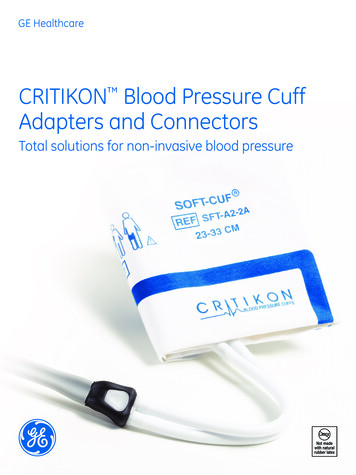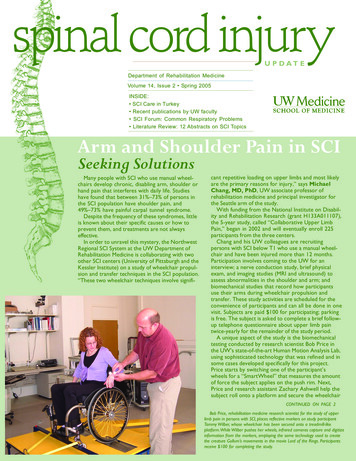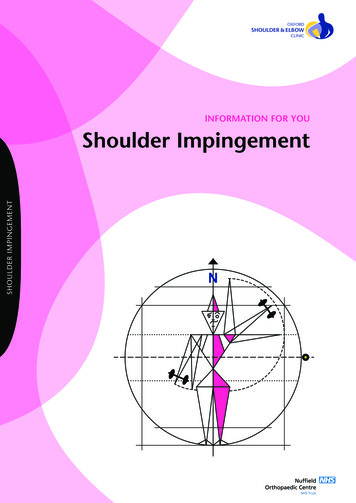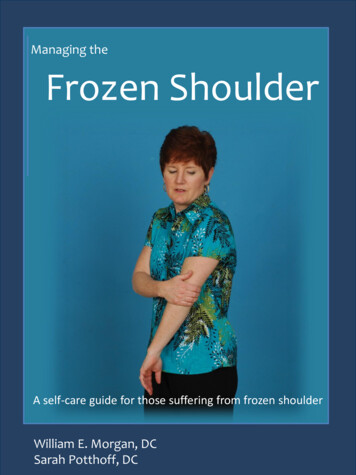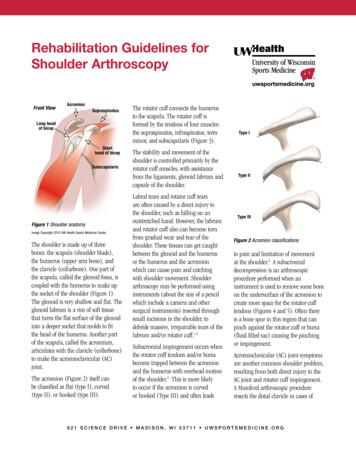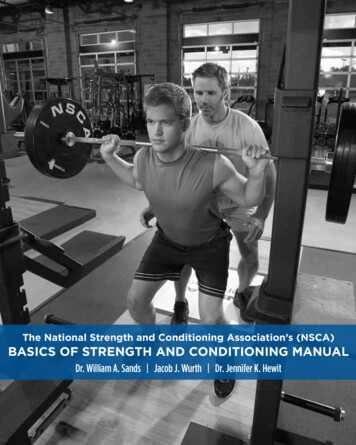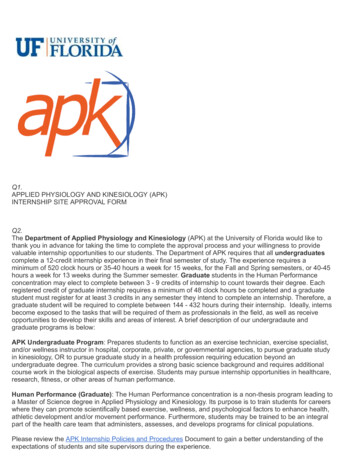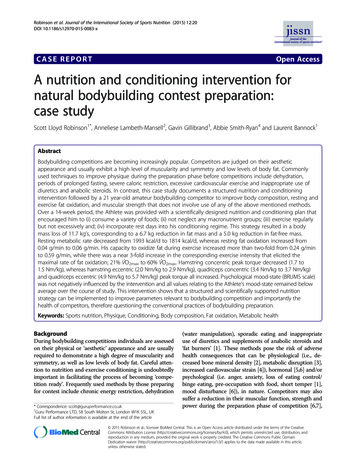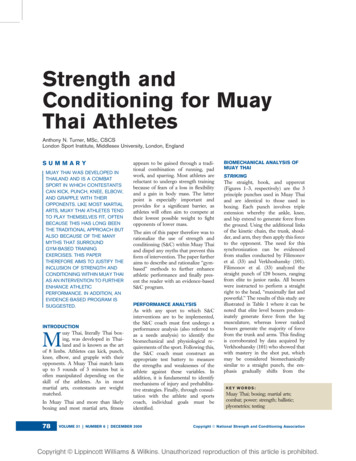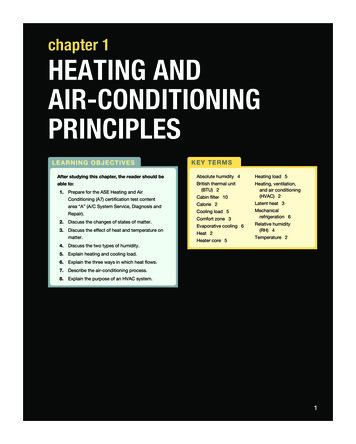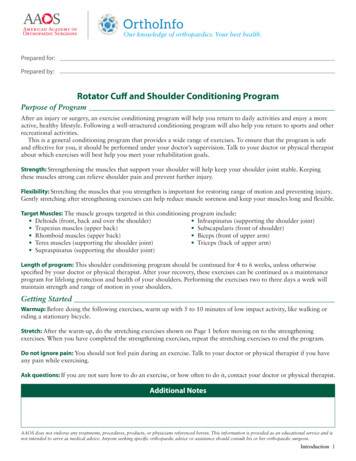
Transcription
Our knowledge of orthopaedics. Your best health.Prepared for:Prepared by:Rotator Cuff and Shoulder Conditioning ProgramPurpose of ProgramAfter an injury or surgery, an exercise conditioning program will help you return to daily activities and enjoy a moreactive, healthy lifestyle. Following a well-structured conditioning program will also help you return to sports and otherrecreational activities.This is a general conditioning program that provides a wide range of exercises. To ensure that the program is safeand effective for you, it should be performed under your doctor’s supervision. Talk to your doctor or physical therapistabout which exercises will best help you meet your rehabilitation goals.Strength: Strengthening the muscles that support your shoulder will help keep your shoulder joint stable. Keepingthese muscles strong can relieve shoulder pain and prevent further injury.Flexibility: Stretching the muscles that you strengthen is important for restoring range of motion and preventing injury.Gently stretching after strengthening exercises can help reduce muscle soreness and keep your muscles long and flexible.Target Muscles: The muscle groups targeted in this conditioning program include: Deltoids (front, back and over the shoulder) Infraspinatus (supporting the shoulder joint) Trapezius muscles (upper back) Subscapularis (front of shoulder) Biceps (front of upper arm) Rhomboid muscles (upper back) Triceps (back of upper arm) Teres muscles (supporting the shoulder joint) Supraspinatus (supporting the shoulder joint)Length of program: This shoulder conditioning program should be continued for 4 to 6 weeks, unless otherwisespecified by your doctor or physical therapist. After your recovery, these exercises can be continued as a maintenanceprogram for lifelong protection and health of your shoulders. Performing the exercises two to three days a week willmaintain strength and range of motion in your shoulders.Getting StartedWarmup: Before doing the following exercises, warm up with 5 to 10 minutes of low impact activity, like walking orriding a stationary bicycle.Stretch: After the warm-up, do the stretching exercises shown on Page 1 before moving on to the strengtheningexercises. When you have completed the strengthening exercises, repeat the stretching exercises to end the program.Do not ignore pain: You should not feel pain during an exercise. Talk to your doctor or physical therapist if you haveany pain while exercising.Ask questions: If you are not sure how to do an exercise, or how often to do it, contact your doctor or physical therapist.Additional NotesAAOS does not endorse any treatments, procedures, products, or physicians referenced herein. This information is provided as an educational service and isnot intended to serve as medical advice. Anyone seeking specific orthopaedic advice or assistance should consult his or her orthopaedic surgeon.Introduction 1
Our knowledge of orthopaedics. Your best health.Rotator Cuff and Shoulder Conditioning ProgramSTRETCHING EXERCISES1. PendulumRepetitionsMain muscles worked: Deltoids, supraspinatus, infraspinatus, subscapularis2 sets of 10Equipment needed: NoneDays per week5 to 6Step-by-step directions L ean forward and place one hand on a counter or table forsupport. Let your other arm hang freely at your side. G ently swing your arm forward and back. Repeat the exercisemoving your arm side-to-side, and repeat again in a circularmotion. Repeat the entire sequence with the other arm.TipDo not round your back or lock your knees.2. Crossover Arm StretchRepetitions4 each sideMain muscles worked: Posterior deltoidYou should feel this stretch at the back of your shoulderEquipment needed: NoneDays per week5 to 6Step-by-step directions R elax your shoulders and gently pull one arm across your chest as far aspossible, holding at your upper arm. Hold the stretch for 30 seconds and then relax for 30 seconds. Repeat with the other arm.TipDo not pull or put pressure on your elbow.AAOS does not endorse any treatments, procedures, products, or physicians referenced herein. This information is provided as an educational service and isnot intended to serve as medical advice. Anyone seeking specific orthopaedic advice or assistance should consult his or her orthopaedic surgeon. American Academy of Orthopaedic SurgeonsExercises Page 1
Our knowledge of orthopaedics. Your best health.Rotator Cuff and Shoulder Conditioning ProgramSTRETCHING EXERCISES3. Passive Internal RotationRepetitions4 each sideMain muscles worked: SubscapularisYou should feel this stretch at the front of your shoulderEquipment needed: Light stick, such as a yardstickDays per week5 to 6Step-by-step directions H old a stick behind your back with one hand, and lightlygrasp the other end of the stick with your other hand. P ull the stick horizontally as shown so that your shoulder ispassively stretched to the point of feeling a pull without pain. Hold for 30 seconds and then relax for 30 seconds. Repeat on the other side.TipDo not lean over or twist to side while pulling the stick.4. Passive External RotationRepetitions4 each sideMain muscles worked: Infraspinatus, teres minorYou should feel this stretch in the back of your shoulderEquipment needed: Light stick, such as a yardstickDays per week5 to 6Step-by-step directions G rasp the stick with one hand and cup the other end of thestick with the other hand. K eep the elbow of the shoulder you are stretching againstthe side of your body and push the stick horizontally asshown to the point of feeling a pull without pain. Hold for 30 seconds and then relax for 30 seconds. Repeat on the other side.TipKeep your hips facing forward and do not twist.AAOS does not endorse any treatments, procedures, products, or physicians referenced herein. This information is provided as an educational service and isnot intended to serve as medical advice. Anyone seeking specific orthopaedic advice or assistance should consult his or her orthopaedic surgeon. American Academy of Orthopaedic SurgeonsExercises Page 2
Our knowledge of orthopaedics. Your best health.Rotator Cuff and Shoulder Conditioning ProgramSTRETCHING EXERCISES5. Sleeper StretchRepetitions4 reps, 3x a dayMain muscles worked: Infraspinatus, teres minorYou should feel this stretch in your outer upper back, behind your shoulderEquipment needed: NoneDays per weekDailyStep-by-step directions L ie on your side on a firm, flat surface with the affectedshoulder under you and your arm bent, as shown. You canplace your head on a pillow for comfort, if needed. U se your unaffected arm to push your other arm down. Stoppressing down when you feel a stretch in the back of youraffected shoulder. H old this position for 30 seconds, then relax your arm for30 seconds.TipDo not bend your wrist or press down on your wrist.AAOS does not endorse any treatments, procedures, products, or physicians referenced herein. This information is provided as an educational service and isnot intended to serve as medical advice. Anyone seeking specific orthopaedic advice or assistance should consult his or her orthopaedic surgeon. American Academy of Orthopaedic SurgeonsExercises Page 3
Our knowledge of orthopaedics. Your best health.Rotator Cuff and Shoulder Conditioning ProgramSTRENGTHENING EXERCISES6. Standing RowRepetitions3 sets of 8Days per week3Main muscles worked: Middle and lower trapeziusYou should feel this exercise at the back of your shoulder and into your upper back Equipment needed: Use an elastic stretch band of comfortable resistance. As the exercise becomeseasier to perform, progress to 3 sets of 12 repetitions. If you have access to a fitness center, thisexercise can also be performed on a weight machine. A fitness assistant at your gym can instructyou on how to use the machines safely.Step-by-step directions M ake a 3-foot-long loop with the elastic band and tie the endstogether. Attach the loop to a doorknob or other stable object. S tand holding the band with your elbow bent and at your side, asshown in the start position. K eep your arm close to your side and slowly pull your elbowstraight back. Slowly return to the start position and repeat.TipSqueeze your shoulder blades together as you pull.7. External Rotation With Arm Abducted 90 Repetitions3 sets of 8Days per week3Main muscles worked: Infraspinatus and teres minorYou should feel this exercise at the back of your shoulder and into your upper backEquipment needed: Use an elastic stretch band of comfortable resistance. As the exercise becomeseasier to perform, progress to 3 sets of 12 repetitions. If you have access to a fitness center, this exercise can also be performed on a weight machine. A fitness assistant at your gym can instruct youon how to use the machines safely.Step-by-step directions M ake a 3-foot-long loop with the elastic band and tie the endstogether. Attach the loop to a doorknob or other stable object. S tand holding the band with your elbow bent 90 and raised toshoulder-height, as shown in the start position. K eeping your shoulder and elbow level, slowly raise your handuntil it is in line with your head. Slowly return to the start position and repeat.TipMake sure your elbow stays in line with your shoulder.AAOS does not endorse any treatments, procedures, products, or physicians referenced herein. This information is provided as an educational service and isnot intended to serve as medical advice. Anyone seeking specific orthopaedic advice or assistance should consult his or her orthopaedic surgeon. American Academy of Orthopaedic SurgeonsExercises Page 4
Our knowledge of orthopaedics. Your best health.Rotator Cuff and Shoulder Conditioning ProgramSTRENGTHENING EXERCISES8. Internal RotationRepetitions3 sets of 8Days per week3Main muscles worked: Pectoralis, subscapularisYou should feel this exercise at your chest and shoulder Equipment needed: Use an elastic stretch band of comfortable resistance. As the exercise becomeseasier to perform, progress to 3 sets of 12 repetitions. If you have access to a fitness center, thisexercise can also be performed on a weight machine. A fitness assistant at your gym can instructyou on how to use the machines safely.Step-by-step directions M ake a 3-foot-long loop with the elastic band and tie the endstogether. Attach the loop to a doorknob or other stable object. S tand holding the band with your elbow bent and at your side,as shown in the start position. Keep your elbow close to your side and bring your arm across your body. Slowly return to the start position and repeat.TipKeep your elbow pressed into yourside.StartFinish9. External RotationRepetitions3 sets of 8Days per week3Main muscles worked: Infraspinatus, teres minor, posterior deltoidYou should feel this stretch in the back of your shoulder and upper backEquipment needed: Use an elastic stretch band of comfortable resistance. As the exercise becomeseasier to perform, progress to 3 sets of 12 repetitions. If you have access to a fitness center, this exercise can also be performed on a weight machine. A fitness assistant at your gym can instruct youon how to use the machines safely.Step-by-step directions M ake a 3-foot-long loop with the elastic band and tie the ends together.Attach the loop to a doorknob or other stable object. S tand holding the band with your elbow bent and at your side, asshown in the start position. Keeping your elbow close to your side, slowly rotate your arm outward. Slowly return to the start position and repeat.TipSqueeze your shoulder blades together when you pull your elbow back.StartFinishAAOS does not endorse any treatments, procedures, products, or physicians referenced herein. This information is provided as an educational service and isnot intended to serve as medical advice. Anyone seeking specific orthopaedic advice or assistance should consult his or her orthopaedic surgeon. American Academy of Orthopaedic SurgeonsExercises Page 5
Our knowledge of orthopaedics. Your best health.Rotator Cuff and Shoulder Conditioning ProgramSTRENGTHENING EXERCISES10. Elbow FlexionRepetitions3 sets of 8Days per week3Main muscles worked: BicepsYou should feel this exercise at the front of your upper armEquipment needed: Begin with a weight that allows 3 sets of 8 repetitions and progress to3 sets of 12 repetitions. As the exercise becomes easier, add weight in 1-pound increments to amaximum of 5 pounds. Each time you increase the weight, start again at 3 sets of 8 repetitions.Step-by-step directions Stand tall with your weight evenly distributed over both feet. K eep your elbow close to your side and slowly bring the weight uptoward your shoulder as shown. Hold for 2 seconds. Slowly return to the starting position and repeat.TipDo not do the exercise too quickly or swing your arm.11. Elbow ExtensionRepetitions3 sets of 8Days per week3Main muscles worked: TricepsYou should feel this exercise at the back of your upper armEquipment needed: Begin with a weight that allows 3 sets of 8 repetitions and progress to 3 sets of12 repetitions. As the exercise becomes easier, add weight in 1-pound increments to a maximum of5 pounds. Each time you increase the weight, start again at 3 sets of 8 repetitions.Step-by-step directions Stand tall with your weight evenly distributed over both feet. R aise your arm and bend your elbow with the weight behind your head.Support your arm by placing your opposite hand on your upper arm. Slowly straighten your elbow and bring the weight overhead. Hold for 2 seconds. Slowly lower your arm back down behind your head and repeat.TipKeep your abdominal muscles tight and do not arch your back.AAOS does not endorse any treatments, procedures, products, or physicians referenced herein. This information is provided as an educational service and isnot intended to serve as medical advice. Anyone seeking specific orthopaedic advice or assistance
Warmup: Before doing the following exercises, warm up with 5 to 10 minutes of low impact activity, like walking or riding a stationary bicycle. Stretch: After the warm-up, do the stretching exercises shown on Page 1 before moving on to the strengthening exercises. When you have completed the strengthening exercises, repeat the stretching exercises to end the program. Do not ignore pain: You .
